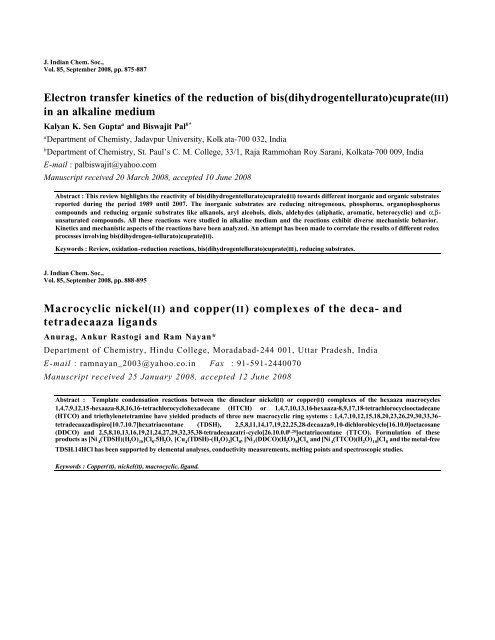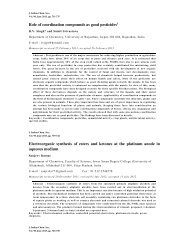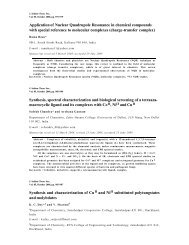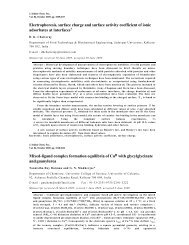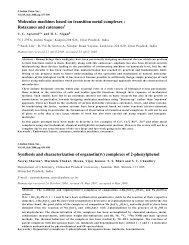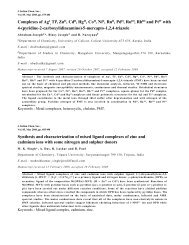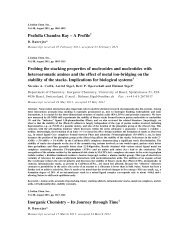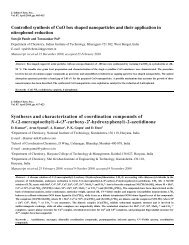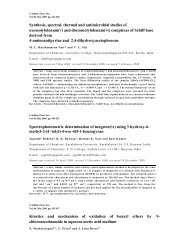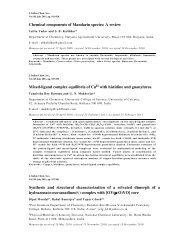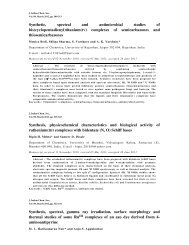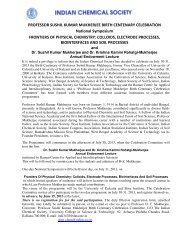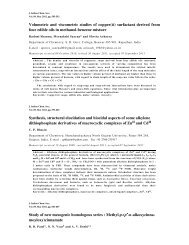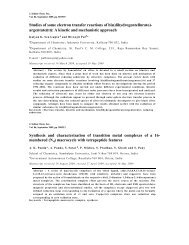Abstracts of Journal of Indian Chemical Society Vol.85, September ...
Abstracts of Journal of Indian Chemical Society Vol.85, September ...
Abstracts of Journal of Indian Chemical Society Vol.85, September ...
You also want an ePaper? Increase the reach of your titles
YUMPU automatically turns print PDFs into web optimized ePapers that Google loves.
J. <strong>Indian</strong> Chem. Soc.,<br />
Vol. 85, <strong>September</strong> 2008, pp. 875-887<br />
Electron transfer kinetics <strong>of</strong> the reduction <strong>of</strong> bis(dihydrogentellurato)cuprate(III)<br />
in an alkaline medium<br />
Kalyan K. Sen Gupta a and Biswajit Pal b*<br />
a Department <strong>of</strong> Chemisty, Jadavpur University, Kolk ata-700 032, India<br />
b Department <strong>of</strong> Chemistry, St. Paul’s C. M. College, 33/1, Raja Rammohan Roy Sarani, Kolkata-700 009, India<br />
E-mail : palbiswajit@yahoo.com<br />
Manuscript received 20 March 2008, accepted 10 June 2008<br />
Abstract : This review highlights the reactivity <strong>of</strong> bis(dihydrogentellurato)cuprate(III) towards different inorganic and organic substrates<br />
reported during the period 1989 until 2007. The inorganic substrates are reducing nitrogeneous, phosphorus, organophosphorus<br />
compounds and reducing organic substrates like alkanols, aryl alcohols, diols, aldehydes (aliphatic, aromatic, heterocyclic) and a,bunsaturated<br />
compounds. All these reactions were studied in alkaline medium and the reactions exhibit diverse mechanistic behavior.<br />
Kinetics and mechanistic aspects <strong>of</strong> the reactions have been analyzed. An attempt has been made to correlate the results <strong>of</strong> different redox<br />
processes involving bis(dihydrogen-tellurato)cuprate(III).<br />
Keywords : Review, oxidation-reduction reactions, bis(dihydrogentellurato)cuprate(III), reducing substrates.<br />
J. <strong>Indian</strong> Chem. Soc.,<br />
Vol. 85, <strong>September</strong> 2008, pp. 888-895<br />
Macrocyclic nickel(II) and copper(II) complexes <strong>of</strong> the deca- and<br />
tetradecaaza ligands<br />
Anurag, Ankur Rastogi and Ram Nayan*<br />
Department <strong>of</strong> Chemistry, Hindu College, Moradabad-244 001, Uttar Pradesh, India<br />
E-mail : ramnayan_2003@yahoo.co.in Fax : 91-591-2440070<br />
Manuscript received 25 January 2008, accepted 12 June 2008<br />
Abstract : Template condensation reactions between the dinuclear nickel(II) or copper(II) complexes <strong>of</strong> the hexaaza macrocycles<br />
1,4,7,9,12,15-hexaaza-8,8,16,16-tetrachlorocyclohexadecane (HTCH) or 1,4,7,10,13,16-hexaaza-8,9,17,18-tetrachlorocyclooctadecane<br />
(HTCO) and triethylenetetramine have yielded products <strong>of</strong> three new macrocyclic ring systems : 1,4,7,10,12,15,18,20,23,26,29,30,33,36-<br />
tetradecaazadispiro[10.7.10.7]hexatriacontane (TDSH), 2,5,8,11,14,17,19,22,25,28-decaaza-9,10-dichlorobicyclo[16.10.0]octacosane<br />
(DDCO) and 2,5,8,10,13,16,19,21,24,27,29,32,35,38-tetradecaazatri-cyclo[26.10.0.0 9,20 ]octatriacontane (TTCO). Formulation <strong>of</strong> these<br />
products as [Ni 4<br />
(TDSH)(H 2<br />
O) 10<br />
]Cl 8<br />
.5H 2<br />
O, [Cu 4<br />
(TDSH)-(H 2<br />
O) 2<br />
]Cl 8<br />
, [Ni 3<br />
(DDCO)(H 2<br />
O) 8<br />
]Cl 6<br />
and [Ni 4<br />
(TTCO)(H 2<br />
O) 10<br />
]Cl 8<br />
and the metal-free<br />
TDSH.14HCl has been supported by elemental analyses, conductivity measurements, melting points and spectroscopic studies.<br />
Keywords : Copper(II), nickel(II), macrocyclic, ligand.
J. <strong>Indian</strong> Chem. Soc.,<br />
Vol. 85, <strong>September</strong> 2008, pp. 896-900<br />
Synthesis and spectral studies <strong>of</strong> nitrogen-oxygen donor macrocyclic metal<br />
complexes <strong>of</strong> Mn II , Cu II , Zn II , Pd II and Pt II<br />
Sulekh Chandra a* , Shweta Verma a and P. Meera b<br />
a Department <strong>of</strong> Chemistry, Zakir Husain College (University <strong>of</strong> Delhi), JLN Marg, New Delhi-110 002, India<br />
E-mail : schandra_00@yahoo.com; shweta_verma@rediffmail.com Fax : 91-11-23215906<br />
b Physical & Materials Chemistry, National <strong>Chemical</strong> Laboratory, Pune-411 008, Maharashtra, India<br />
Manuscript received 1 November 2007, revised 15 May 2008, accepted 25 June 2008<br />
Abstract : The complexes <strong>of</strong> Mn II , Cu II , Zn II , Pd II and Pt II with a nitrogen-oxygen donor macrocyclic ligand, viz. 5,6,13,14-<br />
dibenzo[1,4,8,11]dioxadiaza-5,7,11,13-cyclote tradecin have been synthesized and characterized by elemental analysis, molar conductance,<br />
magnetic susceptibility measurements, spectral and electrochemical studies. The molar conductance measurements <strong>of</strong> the complexes in<br />
DMF solution correspond to non electrolytic nature for M(L)X 2<br />
complexes and 1 : 2 electrolytes for M¢(L)X 2<br />
complexes [where M = Mn II ,<br />
Cu II ; M¢ = Zn II , Pd II and Pt II ; X = Cl – , NO – 3 and L = ligand]. Thus, the complexes may be formulated as [M(L)X 2 ] and [M¢(L)]X 2<br />
respectively. Mn II , Cu II complexes were <strong>of</strong> the high-spin type whereas the complexes <strong>of</strong> Zn II , Pd II and Pt II were diamagnetic. On the basis <strong>of</strong><br />
spectral studies an octahedral geometry has been assigned for Mn II , tetragonal for Cu II , tetrahedral for Zn II complexes whereas square<br />
planar for Pd II and Pt II complexes.<br />
Keywords : Macrocyclic, Mn II , Cu II , Zn II , Pd II , Pt II .<br />
J. <strong>Indian</strong> Chem. Soc.,<br />
Vol. 85, <strong>September</strong> 2008, pp. 901-910<br />
Studies on the solubilities and dissociation constants <strong>of</strong> substituted benzoic<br />
acids in 2-propanol-water mixtures and ion-solvent interactions<br />
Rupasri Mandal (Karan) and Sujit Chandra Lahiri*<br />
Department <strong>of</strong> Chemistry, University <strong>of</strong> Kalyani, Kalyani-741 235, West Bengal, India<br />
E-mail : sujitclahiri@yahoo.com<br />
Manuscript received 21 May 2008, accepted 10 June 2008<br />
Abstract : The solvational behaviour <strong>of</strong> 2- and 3-substituted bromo- and iodo -benzoic acids have been examined from the solubility <strong>of</strong> the<br />
acids and the dissociation constants for the reaction<br />
HA = H + + A – (where HA is substituted benzoic acid)<br />
determined conductometrically using Fuoss-Kraus method in 2-propanol + water mixtures (0–87 mass% <strong>of</strong> 2-propanol). The changes in the<br />
solubility values depend on the hydrophobic character and the dielectric constant <strong>of</strong> the solvent medium. The Gibbs energy <strong>of</strong> transfer for<br />
anions have been determined from the relation<br />
DG° t<br />
(dissn.) = DG° t<br />
(H + ) + DG° t<br />
(A – ) – DG° t<br />
(HA)<br />
using the previously determined values <strong>of</strong> DG° t<br />
(H + ). DG° t<br />
(A – ) values have been found to be increasingly positive in aquo-organic mixtures<br />
and the DG° t<br />
(A – ) values <strong>of</strong> the 3-compounds are considerably different from those <strong>of</strong> 2-compounds. The results are discussed in the light <strong>of</strong><br />
solute-solvent interactions. The effects <strong>of</strong> substitution on the interaction energies <strong>of</strong> anions have been determined.<br />
Keywords : Ion-solvent interaction, dissociation constant, benzoic acid , conductivity measurement.
J. <strong>Indian</strong> Chem. Soc.,<br />
Vol. 85, <strong>September</strong> 2008, pp. 911-919<br />
Fullerene-DBP conjugates : Their co-occurrence in meteorites, ammonites and<br />
Shilajit, and application in systemic drug delivery<br />
Shibnath Ghosal* and Muruganandam A. V.<br />
R & D Centre, <strong>Indian</strong> Herbs Ltd., Saharanpur-247 001, Uttar Pradesh, India<br />
E-mail : vishnu20024@rediffmail.com<br />
Manuscript received 5 August 2008, accepted 12 August 2008<br />
Abstract : A unified manifestation <strong>of</strong> the macrocosmic and microcosmic actions is expressed by the co-occurrence <strong>of</strong> C 60<br />
-fullerene-dibenzoa-pyrone<br />
(DBP) conjugates in meteorites, ammonites, and Shilajit. The crystal forms <strong>of</strong> mineral (aragonite) deposition in ammonites (the<br />
major marine precursors <strong>of</strong> Shilajit), are distinctly different in many respects from the inorganic mineral, aragonite. The mineral<br />
deposition in the living ammonite shells is under strict biological control and involves organo-mineral complexes received from meteorites.<br />
These constituents in ammonites are eventually transformed into Shilajit by humification. Hence, the supramolecular assemblies <strong>of</strong><br />
complex chemical constituents <strong>of</strong> ammonites, in many respects, show striking similarities with the humic constituents (FAs, HAs and HMs)<br />
<strong>of</strong> meteorites and <strong>of</strong> Shilajit. Some selected assemblies, viz. fusoms and DCPs, <strong>of</strong> Shilajit, comprising <strong>of</strong> fullerene-DBP conjugates in their<br />
inner core, were found to confer facile water-solubility, stability and superior bioavailability (Yogabahi in Ayurveda) to a host <strong>of</strong> chemical<br />
agents that are ordinarily water-insoluble, thermolabile, autoxidizable, and/or prematurely biodegradable before reaching the target site.<br />
The potential <strong>of</strong> this superior drug delivery system is evaluated.<br />
Keywords : Meteorites, ammonites, Shilajit, fullerene-DBP conjugates, drug delivery.<br />
J. <strong>Indian</strong> Chem. Soc.,<br />
Vol. 85, <strong>September</strong> 2008, pp. 920-925<br />
Comparative rate study on the oxidation <strong>of</strong> nicotinamide and isonicotinamide by<br />
permanganate in acidic medium<br />
Ashok Sharma a , Punit K. Mudgal and K. S. Gupta *<br />
Department <strong>of</strong> Chemistry, University <strong>of</strong> Rajasthan, Jaipur-302 004, Rajasthan, India<br />
E-mail : guptaks14@rediffmail.com<br />
a<br />
Government College, Dausa, Rajasthan, India<br />
Manuscript received 25 April 2007, revised 12 February 2008, accepted 3 June 2008<br />
Abstract : A comparative rate study on the oxidation <strong>of</strong> nicotinamide and isonicotinamide by potassium permanganate has been carried<br />
out in acidic solutions over an extended [H + ]-range (1 · 10 –5 –1.0 mol L –1 ). Under the similar reaction conditions, the oxidation <strong>of</strong> pyridine is<br />
imperceptible. Further, in the absence <strong>of</strong> acid none <strong>of</strong> the two amides is oxidized and in both cases, the N-protonated amide species appears<br />
to be reactive. For nicotinamide, the results are in agreement with the two-term rate law (A). The oxidation product was corresponding N-<br />
oxide.<br />
–d[MnO 4–<br />
]/dt = (k 0<br />
K + k 1<br />
KK 1<br />
[H + ]) [S ] 0<br />
[MnO 4–<br />
] t<br />
[H + ]/(1 + K [H + ])<br />
(A)<br />
On the other hand, the oxidation <strong>of</strong> isonicotinamide follows a simpler rate law (B).<br />
–d[MnO 4–<br />
]/dt = k 0<br />
K [S] 0<br />
[MnO 4–<br />
] t<br />
[H + ]/(1 + K [H + ])<br />
The values <strong>of</strong> k 0<br />
, K and k 1<br />
K l<br />
for nicotinamide were found to be 5.5 · 10 –3 L mol –1 s –1 , 1.8 · 10 4 and 1.0 · 10 –2 L mol –1 s –1 , respectively at 35<br />
o<br />
C. And for isonicotinamide, the k 0<br />
and K values were 4.4 · 10 –3 L mol –1 s –1 and 5.6 · 10 3 respectively at 35 o C. The oxidation <strong>of</strong><br />
nicotinamide is faster than the oxidation <strong>of</strong> isonicotinamide. It appears that the presence <strong>of</strong> -CONH 2<br />
group at position 3 activates the ring<br />
nitrogen more for oxidation than the presence <strong>of</strong> this group at position 4.<br />
Keywords : Permanganate, nicotinamide, isonicotinamide, oxidation, kinetics, N-protonation.<br />
(B)
J. <strong>Indian</strong> Chem. Soc.,<br />
Vol. 85, <strong>September</strong> 2008, pp. 926-929<br />
Spectral and equilibrium studies on some new derivatives <strong>of</strong> 4-amino-5-phenyl-<br />
3-mercapto-1,2,4-triazole<br />
Aliya, B. Sireesha, Ch. Venkata Ramana Reddy and Ch. Sarala Devi*<br />
Department <strong>of</strong> Chemistry, Nizam College, Osmania University, Hyderabad-500 001, India<br />
E-mail : dr_saraladevich@yahoo.com<br />
Manuscript received 1 October 2007, revised 3 June 2008, accepted 17 June 2008<br />
Abstract : 4-Amino-5-phenyl-3-mercapto-l,2,4-triazole (APMT), 4-(4¢-methoxy)benzylidineamino-5-phenyl-3-mercapto-l,2,4-triazole<br />
(PMBPMT), 4-benzylidineamino-5-phenyl-3-mercapto-l,2,4-triazole (BPMT), 4-(2¢-hydroxy)benzylidineamino-5-phenyl-3-mercapto-l,2,4-<br />
triazole (HBPMT) and 4-amino-5-(4¢-nitro)phenyl-3-mercapto-l,2,4-triazole (ANPMT) were synthesized and characterized by elemental<br />
analyses, IR, 1 H NMR, 13 C NMR, DEPT and Mass spectral studies. Proton dissociation constants <strong>of</strong> these compounds in 70% v/v dioxanwater<br />
medium at 303 K and 0.l M (KNO 3<br />
) ionic strength were measured. The order <strong>of</strong> the pK a<br />
corresponding to mercapto group follows<br />
the sequence : PMBPMT > BPMT > HBPMT > APMT > ANPMT.<br />
Keywords : 1,2,4-Triazoles, IR, I H NMR, 13 C NMR, DEPT, dissociation constants.<br />
J. <strong>Indian</strong> Chem. Soc.,<br />
Vol. 85, <strong>September</strong> 2008, pp. 930-935<br />
Extraction chromatographic studies <strong>of</strong> uranium(VI) with crosslinked<br />
poly(acrylic acid) coated on silica gel<br />
Bhabatosh Mandal*, Pranesh Chowdhury* and Susanta K. Pandit<br />
Analytical Laboratory, Department <strong>of</strong> Chemistry, Visva-Bharati, Santiniketan-731 235, West Bengal, India<br />
E-mail : bhabatosh_mandal@yahoo.co.in<br />
Manuscript received 16 October 2007, revised 12 May 2008, accepted 25 June 2008<br />
Abstract : A selective method has been developed for extraction and separation <strong>of</strong> U VI with the chemically synthesized high molecular mass<br />
crosslinked poly(acrylic acid) coated on silanized silica gel. The coated materials act as a stationary phase for the extraction<br />
chromatographic studies. The structure and thermal stability <strong>of</strong> crosslinked poly(acrylic acid) has been elucidated with the help <strong>of</strong> FTIR<br />
and TGA. The optimum pH range for quantitative extraction <strong>of</strong> uranium was found to be 4 to 6. The effects <strong>of</strong> pH and stripping agent on<br />
extraction and elution <strong>of</strong> U VI have been investigated. Ion exchange and break-through capacity <strong>of</strong> the exchanger (polymer coated on<br />
silanized silica gel) have been determined at room temperature. Surface morphology <strong>of</strong> the exchanger was studied by SEM. U VI has been<br />
separated quantitatively from various synthetic aqueous mixtures containing metal ions (V IV , Th IV , Ce IV , Pb Il , Hg Il , In III , Fe III and Zr IV )<br />
commonly present in uranium ores and fission produ cts. The method permits pre -concentration and sequential separation <strong>of</strong> U VI from<br />
Ce VI , Th IV and Zr IV <strong>of</strong> the same analytical group. A plausible mechanism for uranium ion exchange has been suggested.<br />
Keywords : Poly(acrylic acid), silanized silica gel, metal ion, ion-exchange, solid phase extraction.
J. <strong>Indian</strong> Chem. Soc.,<br />
Vol. 85, <strong>September</strong> 2008, pp. 936-941<br />
Synthesis <strong>of</strong> dl-DOPA functionalized chelating resin : Its application in<br />
separation <strong>of</strong> metal ions from environmental samples<br />
Suparna Dutta and Arabinda K. Das*<br />
Department <strong>of</strong> Chemistry, The University <strong>of</strong> Burdwan, Burdwan-713 104, West Bengal, India<br />
E-mail : arabindakdas@rediffmail.com<br />
Manuscript received 6 December 2007, revised 28 April 2008, accepted 25 June 2008<br />
Abstract : Chloromethylated polystyrene-divinylbenzene has been functionalized with 3-(3,4-dihydroxyphenyl) dl -alanine (dl-DOPA). The<br />
resulting chelating resin has been characterized by its elemental analyses, infrared spectroscopy, thermogravimetric analysis and metal ion<br />
sorption capacities. It has been used for the preconcentration and separation <strong>of</strong> Ni II , Co II , Zn II , Cd II and Pb II and their determination by<br />
FAAS. Parameters such as the amount <strong>of</strong> resin, effect <strong>of</strong> pH, equilibration rate, sorption and desorption <strong>of</strong> metal ions and effect <strong>of</strong> diverse<br />
ions have been studied. The sorption capacities increase with increase in pH. Recoveries <strong>of</strong> the metal ions were 96 ± 5, 97 ± 6, 96 ± 5, 95 ± 8<br />
and 96 ± 5 at 95% confidence level whereas the limits <strong>of</strong> detection (LOD) are 4.0, 5.0, 0.5, 1.3 and 25.0 mg L –1 for Ni II , Co II , Zn II , Cd II and<br />
Pb II respectively, The calibration curves were linear up to 8 mg L –1 (R 2 = 0.998), 10 mg L –1 (R 2 = 1.000), 2 mg L –1 (R 2 = 0.998), 2 mg L –1 (R 2<br />
= 1.000) and 5 mg L –1 (R 2 = 0.979) for Ni II , Co II , Zn II , Cd II and Pb II respectively. The reliability <strong>of</strong> the environment friendly method has<br />
been tested by analyzing certified samples.<br />
Keywords : 3-(3,4-Dihydroxyphenyl) dl-alanine (dl-DOPA), chelating resin, solid phase extraction, Ni II , Co II , Zn II , Cd II , Pb II .<br />
J. <strong>Indian</strong> Chem. Soc.,<br />
Vol. 85, <strong>September</strong> 2008, pp. 942-944<br />
Lutein content, fatty acid composition and enzymatic modification <strong>of</strong> lutein from<br />
marigold (Tagetes patula L.) flower petals<br />
Sugata Bhattacharyya a , Anadi Roychowdhury b and Santinath Ghosh b*<br />
a<br />
Quality Control Division, Dey’s Medical Stores (Mfg.) Limited, Bondel Road, Kolkata-700 019, India<br />
E-mail : subbhatt2003@gmail.com<br />
b<br />
Department <strong>of</strong> <strong>Chemical</strong> Technology, University College <strong>of</strong> Science and Technology, University <strong>of</strong> Calcutta,<br />
92, Acharya Prafulla Chandra Road, Kolkata-700 009, India<br />
E-mail : santinathghosh@yahoo.com.hk Fax : 91-33-23519755<br />
Manuscript received 4 April 2008, revised 9 June 2008, accepted 10 June 2008<br />
Abstract : Marigold flower (Tagetes patula L.) is a very good source <strong>of</strong> carotenoid mainly lutein. The marigold flowers <strong>of</strong> three varieties<br />
(orange, yellow and red) are utilized to extract the lutein present in it by using various solvents like hexane, acetone, petroleum ether and<br />
methanol. Among these solvents methanol showed the highest extractability (52.51%). Among the various marigold, orange variety content<br />
the maximum amount <strong>of</strong> lutein <strong>of</strong> 154.96 mg per gram <strong>of</strong> extract. The fatty acid composition <strong>of</strong> the ester fraction was determined and<br />
saturated fatty acid content was maximum (about 75%) and unsaturated fatty acid was about 25%. The lutein ester was also reacted with<br />
capric acid (C 10<br />
) in presence <strong>of</strong> M. miehei immobilized lipase and about 17.5% C 10<br />
fatty acid was incorporated to produce modified lutein<br />
for application in various functional foods.<br />
Keywords : Lutein, fatty acid, marigold petals, Tagetes patula L.
J. <strong>Indian</strong> Chem. Soc.,<br />
Vol. 85, <strong>September</strong> 2008, pp. 945-947<br />
Equilibrium studies <strong>of</strong> Cu II and Ni II ternary complexes with anthranilic acid<br />
derivatives and N,N-donor ligands<br />
B. Krishna Rao a , Ch. Sarala Devi b and Ch. Venkata Ramana Reddy c*<br />
a Department <strong>of</strong> Chemistry, K. U. College <strong>of</strong> Engineering, Kothagudem-507 101, Andhra Pradesh, India<br />
b Department <strong>of</strong> Chemistry, Nizam College, Osmania University, Hyderabad-500 001, India<br />
c Department <strong>of</strong> Chemistry, Chaitanya Bharathi Institute <strong>of</strong> Technology, Gandipet, Hyderabad-500 075, India<br />
E-mail : vrr9@yahoo.com<br />
Manuscript received 29 January 2008, accepted 12 June 2008<br />
Abstract : Equilibrium studies <strong>of</strong> (1 : 1 : 1) ternary, MAL complexes where, M = Cu II and Ni II , L = N-methyl anthranilic acid (NMAA), N-<br />
butyl anthranilic acid (NBAA) and N-phenyl anthranilic acid (NPAA) and A = 2,2-bipyridyl (bipy) and 1,10-phenanthroline (phen) were<br />
carried out pH -metrically at 30 o C and 0.1 M (KNO 3<br />
) ionic strength in aqueous-ethanol (50% v/v) medium. The formation constants <strong>of</strong> the<br />
binary (ML) and ternary complexes were determined under identical conditions for better correlation. The relative stabilities <strong>of</strong> the<br />
ternary complexes are quantified in terms <strong>of</strong> the parameter, D log K. The stabilities <strong>of</strong> the complexes with respect to the ligand, L follow the<br />
order, NBAA > NMAA > NPAA. Various factors influencing the formation and stability <strong>of</strong> the complexes are discussed.<br />
Keywords : Ligand, ternary complexes, formation constants, stability, D log K.<br />
J. <strong>Indian</strong> Chem. Soc.,<br />
Vol. 85, <strong>September</strong> 2008, pp. 948-952<br />
Theoretical estimation <strong>of</strong> viscosity <strong>of</strong> quinary and its constituent quaternary<br />
liquid mixtures<br />
Vinay Sanguri a , Nidhi Singh a , Tanu Srivastava a , Prakash Chandra a , Niti Pandey b and J. D. Pandey a *<br />
a Department <strong>of</strong> Chemistry, University <strong>of</strong> Allahabad, Allahabad-211 002, Uttar Pradesh, India<br />
E-mail : jdpandey@rediffmail.com; drvsanguri@rediffmail.com<br />
b Department <strong>of</strong> Chemistry, Kamla Nehru Institute <strong>of</strong> Science, Sultanpur-228 118, Uttar Pradesh, India<br />
Manuscript received 23 August 2007, revised 10 April 2008, accepted 17 June 2008<br />
Abstract : The present work is concerned with the theoretical analysis <strong>of</strong> quite new and rare data on viscosity <strong>of</strong> a regular quinary and its<br />
quaternary subsystems at 308.15 K and 313.15 K (Nhaesi and Asfour, J. Chem. Eng. Data, 2005, 50, 149). For the first time, six different<br />
relations, viz. Wassiljewa relation, Sutherland-Wassiljewa (S -W) relation, Arrhenius model, Bingham relation, Kendall-Munroe (K-M)<br />
relation and Croenauer-Rothfus-Kermore (C-R-K) relation have been applied to the quinary system (toluene + octane + ethylbenzene +<br />
tetradecane + hexadecane) and its quaternary subsystems.<br />
The theoretical results are compared with experimental viscosity data reported in the aforementioned papers. Quite interesting results<br />
are obtained.<br />
Keywords : Quinary liquid system, viscosity, Wassiljewa relation, Arrhenius model.
J. <strong>Indian</strong> Chem. Soc.,<br />
Vol. 85, <strong>September</strong> 2008, pp. 953-958<br />
New N-galactosides : Synthesis <strong>of</strong> N-galactosylated thiocarbamides,<br />
benzothiazolyl thiocarbamides and thiocarbamates<br />
Prashant R. Mahalle, Gajanan V. Korpe and Shirish P. Deshmukh*<br />
P.G. Department <strong>of</strong> Chemisty, Shri Shivaji College, Akola-444 001, Maharashtra, India<br />
E-mail : prmahalle@rediffmail.com<br />
Manuscript received 22 August 2007, revised 22 May 2008, accepted 3 June 2008<br />
Abstract : The title compounds were prepared by the condensation <strong>of</strong> tetra-O-acetyl-b-D-galactopyranosyl isothiocyanate with several<br />
amines, 2-aminobenzothiazole/substituted benzothiazoles and alcohols respectively. The structure <strong>of</strong> these new N-galactoside has been<br />
established on the basis <strong>of</strong> usual chemical transformations and IR, NMR and Mass spectral studies <strong>of</strong> some typical cases.<br />
Keywords : N-Galactosides, galactosyl isothiocyanate, galactosyl thiocarbamides, galactosyl benzothiazolyl thiocarbamides, galactosyl<br />
thiocarbamates.<br />
J. <strong>Indian</strong> Chem. Soc.,<br />
Vol. 85, <strong>September</strong> 2008, pp. 959-961<br />
Microwave-assisted Vilsmeier-Haack formylation <strong>of</strong> aromatic substrates<br />
Kumaresh Ghosh* and Suman Adhikari<br />
Department <strong>of</strong> Chemistry, University <strong>of</strong> Kalyani, Kalyani-741 235, Nadia, West Bengal, India<br />
E-mail : ghosh_k2003@yahoo.co.in; Fax : 91-33-25828282<br />
Manuscript received 4 March 2008, accepted 17 June 2008<br />
Abstract : A microwave -assisted Vilsmeier-Haack formylation reaction has been studied on various amines, phenols and polynuclear<br />
hydrocarbons under solvent free condition that rapidly affords higher yield <strong>of</strong> products compared to traditional thermal condition.<br />
Keywords : Aromatic compounds, microwave, Vilsmeier-Haack formylation.<br />
J. <strong>Indian</strong> Chem. Soc.,<br />
Vol. 85, <strong>September</strong> 2008, pp. 962-965<br />
Trace determination <strong>of</strong> Pb, Cu, Cd and Zn in Ayurvedic drug, "Mahayograj<br />
Guggulu" via polarographic technique<br />
Shweta Sharma, Priyanka Dhingra and R. S. Pandey *<br />
Department <strong>of</strong> Chemistry, University <strong>of</strong> Rajasthan, Jaipur-302 064, Rajasthan, India<br />
E-mail : shweta19sharma@rediffmail.com; pandey-rajshree@uniraj.ernet.in<br />
Manuscript received 15 October 2007, revised 15 May 2008, accepted 10 June 2008<br />
Abstract : Ayurveda is predominant among India’s traditional health systems and Ayurvedic medicine constitutes around 84% <strong>of</strong> the<br />
sector. However, claims <strong>of</strong> several Ayurvedic products are <strong>of</strong>ten being criticized for not having any scientific evidence and general lack <strong>of</strong><br />
standardization <strong>of</strong> raw materials. A D.C. polarographic method has been proposed for the determination <strong>of</strong> heavy metals like Pb, Cd, Zn,<br />
Cu etc. in Ayurvedic drug – "Mahayograj Guggulu" at mg/L level. The drug was digested with HCl + HNO 3<br />
. The analysis was performed<br />
using 0.1 M HCl (for Zn), 0.25 M acetate buffer (pH = 4.4 ± 0.1) for Cd, Cu, 0.1 M LiClO 4<br />
(pH = 2.2 ± 0.1) for Pb. The concentration <strong>of</strong><br />
metals were in the order Zn > Cd > Cu > Pb. The results were satisfactory and the developed method is simple, rapid and sensitive and can<br />
be applied to the microdetermination <strong>of</strong> the heavy metals in various Ayurvedic drugs.<br />
Keywords : Mahayograj Guggulu, D.C polarography.


